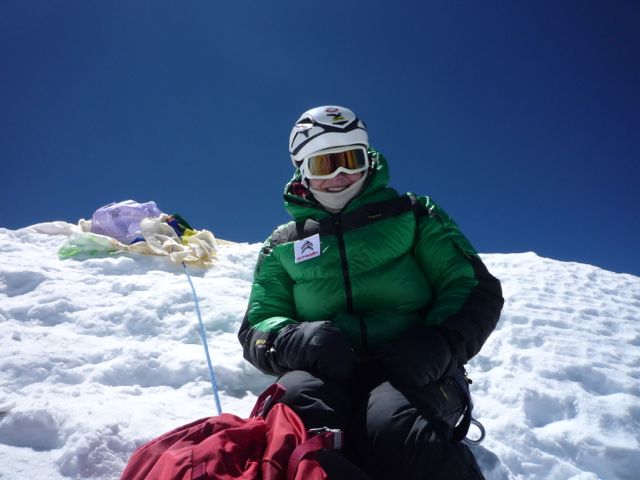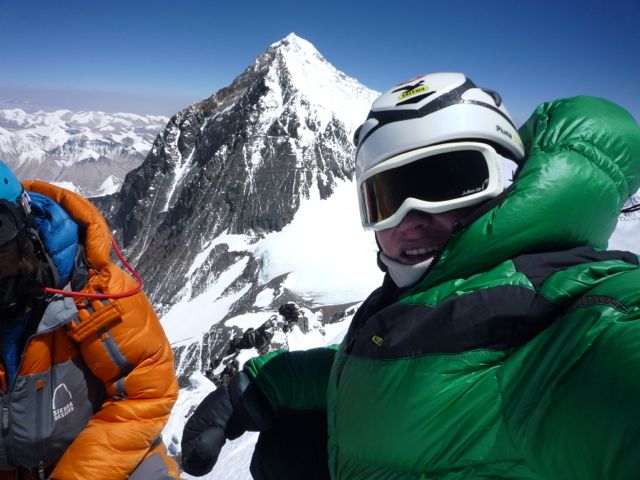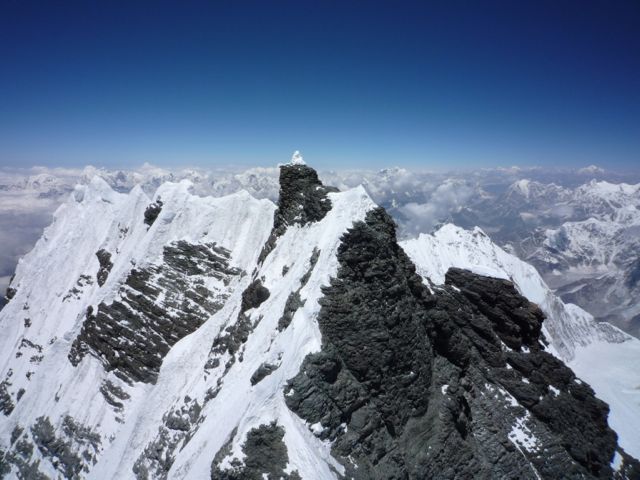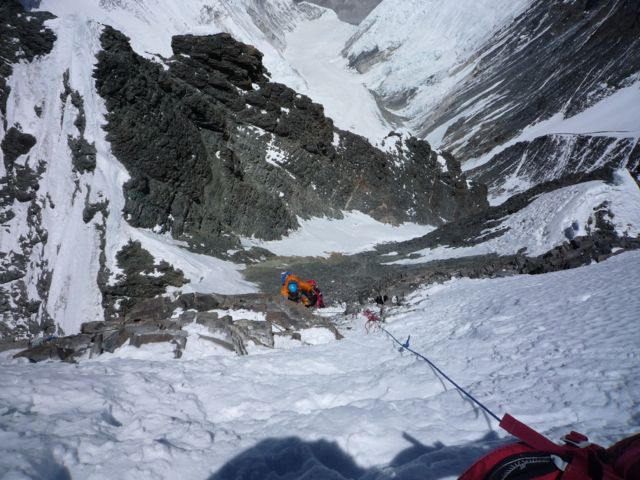Lhotse (8516 m) is the fourth highest mountain in the world, located in the Greater Himalaya range, on the border between China and Nepal. It is numbered among the eight-thousanders that creates so called “The Great Five” – the group of five highest mountains in the world.
I reached the summit of Lhotse on the 25th of May 2012. It was my eight eight-thousander and I climbed it without extra oxygen. I dedicated my ascent to Jerzy Kukuczka, an eminent Polish alpine and high-altitude climber, the second man to climb all fourteen eight-thousanders.
The summit of Lhotse was reached for the first time on the 15th of May 1956 by a Swiss expedition. The first Polish ascent took place in 1979 (Jerzy Kukuczka, Andrzej Czok, Andrzej Heinrich and Janusz Skorek), whereas the first ever winter ascent was made by Pole Krzysztof Wielicki in 1988.
Lhotse was the first and the last eight-thousander that saw Jerzy Kukuczka. He’d ascended it in 1979 and 10 years later he died on its slope attempting to climb the unclimbed 3300-meter high South Face, which is considered to be one of the most difficult in the world. To date, the summit of Lhotse has been reached by 16 Polish climbers and all of these ascents were made via the classic route on the west face.
The summit attack report
I set off to the summit around 01:30 AM. Still bearing in mind my last unsuccessful attempt, I don’t want to make the same mistake once again. I may be exposed to much lower temperatures but I think I’ll survive. Shortly after, it turns out that I can’t really recall if I’ve ever felt so cold before… maybe only on Annapurna. The main reason is the wind that’s got stronger around 06.00 AM. Fortunately, I’m wearing several down layers and this is exactly the reason why I do not have any photos from the couloir. I did not take out my vacuum flask with tea of the backpack either because I was just scared to take my gloves off.
On the summit I took few photos, they’re no good but unfortunately there was no one I could ask to take one from the distance. After 30 minutes I was joined by a couple, an American and a Norwegian, who kindly agreed to take one photo of me on the summit. The rest of the group had already been here before me because they’d used extra oxygen. And if you use oxygen it gets much easier for you to move. From the medical perspective it is more like you ascended a seven-thousander or even a six-thousander. That makes a huge difference.
As far as I know, in this season only one more person managed to climb Lhotse without oxygen, however a Sherpa was reported to have carried the bottle in his backpack along the way. But to make it clear: I do not want to underestimate anyone’s achievements. I am writing about this just to signalize that for me personally it is important to make an ascent without oxygen. If I could not do it this way I would rather resign from attempting to reach the summit and come back another time. However, it may not matter to such an extent to somebody else. It is worth mentioning that if you want to ascend the mountain without oxygen, it is also the tactics itself that differs significantly. One has to acclimatize in a different way and spend some nights as high as possible since Lhotse has been classified as one of the high eight-thousanders, meaning the highest mountains in the world.
Shortly before reaching the summit I met Ania Lichota, a Pole living in Great Britain. She was just descending from the summit together with her Sherpa. We agreed that we would have to meet and have some coffee as soon as she visits Poland.
I got to the top at 10.00 AM. It was a decent time to be there. I recalled all the pieces of advice and drawings I’d got from Piotr Pustelnik and that had been scratched on some photos and tissues in one of the shopping malls in Warsaw. He told me 100 times that I should be careful in order not to reach the wrong summit. “Go for the one on the left.” He was right. I could see some old fixed ropes but they were too scary for me to even touch them.
To tell you the truth, that was a very nice and unforgettable moment for me… for more than 20 minutes I was all by myself on the summit. The visibility was just perfect. I felt like I could almost touch noble Everest, the highest peak in the world. And once again that was wheh history repeated itself – the whole situation was like a déjà vu of what I’d experienced standing on the top of Pumori and staring at Lhotse. Only from such a perspective, Mount Everest does seem beautiful! That was the first time I looked with favour on it.
I promised to myself that if I managed to reached the summit of Lhotse I’d dedicate the ascent to Jerzy Kukuczka, who had died on its south face. And it happened. I even managed to shoot a short film of me actually paying this tribute.
The descent via the coluoir was not pleasant as some other climbers were still going up and those going down caused some stone and scree avalanches. Not only was I tired myself but also had to watch my every step in order not to drop some stones right onto someone’s head. This is very stressful. I was descending slowly and carefully. I was getting more and more hungry and the wind was raging. I had a dilemma: should I stop for a moment and eat something or should I rush down. In the end I was persuaded by the fact that it was high time for me to put on a sunscreen but it turned out that it had frozen.
(This is something I really don’t like: you pay a lot of money for a lotion that is supposed to be great but, honestly, is there a sunscreen that both works in the temperature of -40 centigrade and at the same time provides a SPF of 50? Has it been invented or not? I thought I had already mastered this subject because my skin is hypersensitive to sun but here comes another failure. Eventually, I came back to Poland with a red nose but that’s nothing new really.)
On that occasion I drank some tee and ate a horrible energy bar that at this altitude did not taste like it should, not mentioning the fact that one has to be very careful while eating it because it’s highly possible to break one’s teeth. I kept going down.
After reaching Camp IV I felt too tired to continue, I had to rest. I crawled into my sleeping bag and fell asleep immediately still wearing my suit, crampons and harness. An ascent without oxygen is like spitting one’s lungs out… According to my plan I was to reach Camp II on that day (there was no tent at Camp III) but our “whims” get verified by our lives, as always. Back then, I was just shuddering at the very thought of continuing the descent. (Later, it turned out that I’d made the right decision as my friend from Germany reached the Camp II at 09.00 PM and was totally exhausted whereas the following day it took me only three hours, including a short rest, to cover that distance.)
I decided to stay in Camp IV and have some rest. I started cooking recalling what I had been dreaming about earlier that day: my dream rest. I identified three things that motivated me along my way down, here they are:
1. A flat, comfortable, thick mattress on which I could lay down my sore muscles. Unfortunately, at Camp IV there was only an awfully thin sleeping mat lying directly on the tent floor meaning almost directly on the ice. Still, better be safe than sorry. I just want to stretch my poor spine.
2. A bottle of mineral water. At that time I felt like I’d have given anything for a sip of mineral water instead of the one made of snow that tastes like distilled water. And of course the very melting takes ages.
3. A set of headphones with music in them. At least that was the wish I was prepared for. On an expedition I always have a few iPods with me. Oh, what a great invention it is! And the music itself? It is an equally beautiful mystery, just like mountains.
I fell asleep with the sense of achievement. Well done. It seemed like that day lasted forever.







